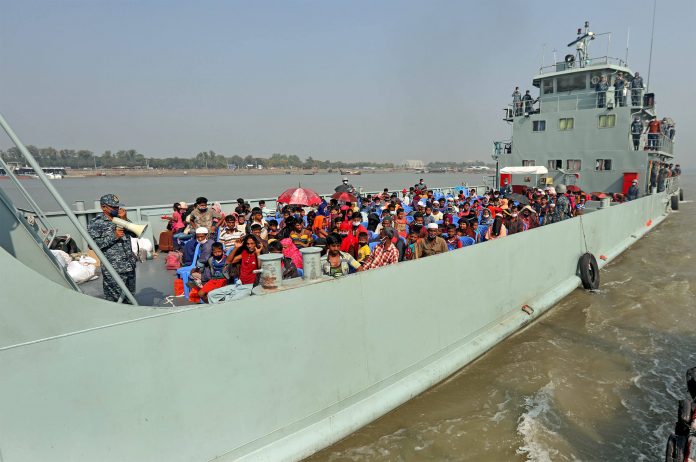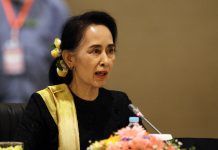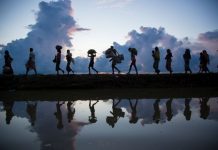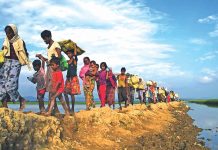This article is written by Daisy Jain, pursuing B.COM.LLB (Hons) from the Institute of Law, Nirma University. This is an exhaustive article which deals with the legality of Bangladesh sending Rohingyas to an island.
Table of Contents
An overview of the status of the Rohingya refugees
The Rohingya are a Muslim-majority ethnic group who dwell primarily in Rakhine, Myanmar’s westernmost region. They use a Bengali dialect rather than the widely prevalent Burmese language. Despite the fact that they have lived in Myanmar for centuries, Myanmar recognizes them as people who came to the nation during the colonial period. As a result, the Rohingyas have not been accorded full citizenship.
As per the Burmese Citizenship Law of 1982, a Rohingya (or any ethnic minority) is only qualified for citizenship if he or she can prove that their forefathers lived in the nation before 1823. They are classed as “resident foreigners” or “associate citizens” (even if one of the parents is a citizen of Myanmar). They are not eligible to work in the public sector because they are not citizens. Within the Rakhine state, their mobility is similarly constrained.
The Rohingya, a Myanmarese ethnic Muslim-minority, has been called by UN Secretary-General Antonio Guterres as “one of, if not the, most oppressed people around the world.” Around 10 lakh Rohingya lived in Myanmar at the beginning of 2017, one of several ethnic minorities in the country. Rakhine state is home to a majority of the Rohingya Muslims. The Myanmar government, on the other hand, regards them as illegitimate Bangladeshi immigrants and has refused to award them citizenship, even leaving them out of the 2014 census. The present issue began in 2017 when militants from the Rohingya Arsa group attacked more than 30 police stations. According to independent reports and testimonials from Rohingya refugees, Myanmar forces responded by burning communities and killing thousands of civilians, frequently with the help of local mobs. At the time of the 2017 migration, there were also genuine claims of sexual abuse against Rohingya girls and women. Thousands of Rohingya Muslims were compelled to flee Myanmar and seek refuge in Bangladesh as a result of the attacks. The majority of them had to stay in the Cox’s Bazar refugee camps in Bangladesh. The Bangladeshi government now plans to relocate at least one-tenth of the Rohingya population to Bhasan Char, an isolated island off the coast of Bangladesh.
The Rohingya crisis
In Myanmar, the Rohingya have been subjected to years of brutality, prejudice, and oppression. After a tremendous outbreak of violence erupted in Myanmar’s Rakhine State in August 2017, more than 700,000 people – 50% of them were children – were forced to flee to Bangladesh. In the 2017 exodus, those escaping assaults and bloodshed joined over 3,00,000 people already in Bangladesh from earlier waves of migration, thus becoming the world’s largest refugee camp. The COVID-19 outbreak has added a new layer of danger to these congested circumstances. Many evacuees live in makeshift bamboo and tarpaulin dwellings, where daily hazards are all too realistic. A fire in Cox’s Bazar on March 22, 2021, caused enormous destruction when it quickly swept over four Rohingya refugee camps.
Genocide against the Rohingya Muslims in 2016
The Rohingyas are a stateless Indo-Aryan ethnic minority who mostly practice Islam and live in Myanmar’s Rakhine state. During the Rohingya genocide in 2016, they were persecuted by the Myanmar Army. More than 8 lakh Rohingya Muslims are said to be living in unsanitary circumstances in Cox’s Bazar camps after fleeing an army campaign in Myanmar’s Rakhine Province in 2016.
Aftermaths of Myanmar’s Rohingya
Since the late 1970s, more than one million Rohingyas have fled Myanmar due to widespread persecution. Rohingyas started to migrate to different parts of the world as refugees such as Saudi Arabia, UAE, Pakistan, Bangladesh, India, and Malaysia. The maximum movement was seen in Bangladesh in which 1 million refugees resided. Bangladesh had to face the consequences as a result of the fleeing of the Rohingyas. As Bangladesh was densely populated, the government decided to start shifting Rohingya refugees to the Bhasan Char Island.
One of the cities of Bangladesh is the Cox Bazar and the government made refugee shelters on the way to Cox Bazar. Only about 7 to 8 lakh Bangladeshi migrants lived in Cox Bazar, out of a total of one million. As a consequence of this, the population density increased in Cox Bazar, and due to which the Bangladesh government was worried about the political implications because of the crisis. The situation was worsened in COVID-19 because of increased community transmission.
2017-18 : plan to decongest Cox Bazaar
As a result of the increment in pollution density in Cox Bazar, the Bangladesh government decided to decongest it. This plan was formed around 2017-18 before COVID-19 because they knew the importance of decongesting the Cox Bazar. In 2017, they decided to shift 1 lakh refugees out of 7-8 lakhs refugees to the island of Bhasan Char which is 39 km far from Naokhali on the mainland. Bhasan Char was not an island before as it has emerged from an ocean. It has been formed through the process of sedimentation. This plan was announced in 2018 by Prime Minister Sheikh Hasina and she said that it is a temporary measure to decongest the refugees and shift them to the Bhasan Char island and after that, a new plan shall be implemented.
Myanmar military stages coup
Myanmar’s military staged a coup which means that the military of Myanmar has taken power over the government on 1st February 2021. The seizure by the military has led to the detention of leaders which includes the de facto leader Aung San Suu Kyi. They also declared that the country shall remain under 1 year of state emergency. The military seizure in Myanmar has sparked outrage among the Rohingya refugees who resided in the camps of Bangladesh. Plenty of them are now afraid to return to their country, but some are still optimistic.
Provisions made for the refugees on the Bhasan Char island
The Bangladesh government has taken such a big step of shifting people to Bhasan Char island which is made through sedimentation. The government has made some provisions in which they have built shelters, masjids, and hospitals. The total estimated cost which the government is bearing is approximately $272 million. The maximum construction is done by the Chinese and British companies. They have built flood embankments and cyclone shelters which can be used to better handle natural disasters, if any, in the future. In fact, the total number of houses that they have built is approximately 1,440 at a height of 4 m from the land because of the fear of submergence and they can accommodate around 1,00,000 people. People here can engage themselves in farming and livestock breeding.
Bangladesh ships Rohingya refugees to the remote island Bhasan Char
The Rohingya refugees reached the low-lying area of Bhasan Char on 4th December 2020. Rohingya families have been relocated from the camps near the Myanmar border to the settlement on Bhasan Char island despite concerns about its safety and lack of consent from the refugees. The 52 sq. km island surfaced in the Bay of Bengal just around 20 years ago. The island which has never been inhabited is flood-prone and vulnerable to frequent cyclones as well. Locals say that high tides flooded the island a few years ago and that cyclones can even cause major storm surges. The Bangladesh government has not involved any international organization including the United Nations in the Rohingya relocation process. However, some national-level NGOs have worked for Rohingyas. The government has planned to bring representatives of some international organizations after the Rohingya stay at the island for some time. It is being said that if Rohingyas give some positive feedback then the Bangladesh government will bring another group of Rohingyas here for a new life.
The facilities on the Bhasan Char island were developed by the Bangladesh government to ensure better living conditions for them compared to congested camps in Cox’s Bazar. The Bangladesh government defending its moves says that moving refugees will ease the overcrowding in its own camps which are now home to more than one million Rohingyas. The United Nations meanwhile in a statement said that it had been given limited information about the relocations and was not involved in any preparations of sending Rohingyas to the island. The United Nations said that it had not been allowed independently to assess the safety, feasibility, and sustainability of the island as a place to live. Bangladesh’s foreign minister AK Abdul Momen dismissed these claims saying that the facilities of the island were much better than those available in the camps. He also added that the government decided to take around 23,000 families voluntarily as the current camps were too congested. Almost a million Rohingyas fled Myanmar in 2017 following a military-led crackdown and most of these communities live in a vast network of camps in Bangladesh.

What is Bhasan Char
Bhasan Char island is a ‘char island’ which is a geographical island that is created because of a silt deposit or sediment deposit at the mouth of the river. It covers around 13,000 acres and was formed by the deposition of silt where the Meghna River meets the Bay of Bengal, which is rich in alluvial deposits. Char island’s literal meaning is ‘shifting landmass’ as it keeps on shifting or it goes inside the water. It is an ecologically fragile island as it keeps on moving. Bhasan Char island is surrounded by Mangrove forests and due to which it has gained geographical stability. In terms of location, it is a two-and-a-half-hour boat ride away from the Cox Bazar in Chittagong.
To provide facilities for these migrants who are sheltering on Bhasan Char island, the Bangladesh government has built roads and purchased advanced telecommunication networks. The Bangladesh government has set aside approximately 1,350 acres for Rohingya refugees, with 432 acres dedicated to their rehabilitation and the remainder set aside for future initiatives. They have been accommodated in red-roofed residential units, with the majority of houses being erected four feet above ground to assist them to endure severe tidal waves.
Yanghee Lee, a former UN Special Rapporteur on the Condition of Human Rights, addressed the Human Rights Council in 2019 by stating that she wasn’t sure if the island was “really livable” even after visiting it. The first wave of 1,642 Rohingya landed at Bhasan Char on 4th December, conveyed by naval warships from Chittagong, as per the Associated Press. Some of the displaced refugees were mentioned in western media as alleging they were not approached for their approval. According to other reports, some Rohingyas are “enthused” to be transported to a new, “peaceful and pleasant” location.
Myanmar and the Rohingya
The migration to Bhasan Char has elicited no response from Myanmar, which does not acknowledge Rohingya as an indigenous population and considers them just as Bengalis. Myanmar tentatively decided to take back some Rohingyas two years ago, but just a small number returned. The army retaliated four years ago against the Arakan Rohingya Salvation Army, which Myanmar described as an Islamist terrorist organization. “The atrocities perpetrated on Rohingya women, men, and children during the August 2017 activities, particularly their indiscriminate slaughter, reach the level of both war and crimes against humanity,” according to the UN-appointed Independent International Fact-finding Committee. According to the report, the Army aimed residents for assassinations, rape, and sexual abuse on a “horror scale.”
The Gambia, with the support of the Organization of Islamic Cooperation, moved Myanmar to the International Court of Justice (ICJ) in November, alleging that it had violated the 1948 Genocide Convention. Myanmar was addressed at the proceedings by State Counselor Aung San Suu Kyi. In January, the International Court of Justice issued a temporary injunction instructing Myanmar to take “all steps within its jurisdiction” to avoid crimes against members of the Rohingya Muslim minority, as required under the Convention on the Prevention and Punishment of Genocide. However, Myanmar is not bound by orders.
Myanmar continues to discriminate against Rohingya Muslims. There were virtually no Rohingya voters in the latest elections, in which Suu Kyi’s party won a larger majority than in 2015 because the military junta had taken away their ability to vote before the poll. Even those who were qualified to vote were unable to do so due to the presence of up to a million Rohingya outside Myanmar and the cancellation of voting in Rakhine state, where a lakh Rohingya still reside. Rohingya candidates’ nominations were denied due to a lack of proof of citizenship. Myanmar is a member of ASEAN, which has failed to resolve the situation. The non-interference principle governs the grouping. Myanmar has sought refuge in China’s arms as a result of worldwide outrage at Suu Kyi’s defence of the army’s practices before the International Court of Justice. In the midst of it all, Bangladesh, which has done more for the Rohingya than any other country, thinks it is within its rights to circumvent UN worries about the move to Bhasan Char.
The legality of this issue
The relocation of Rohingya refugees raises grave human rights concerns. The relocation amounts to nothing more than threatening widespread captivity of the Rohingya refugees and results in infringement of international human rights obligations. The detention of the Rohingya refugees on the Bhasan Char island is a breach of Bangladesh’s responsibilities and liabilities under the International Covenant on Civil and Political Rights (ICCPR), and seriously jeopardizes their freedom of movement and right to liberty. Article 9 of the International Covenant on Civil and Political Rights (ICCPR), to which Bangladesh is a signatory, gives people the right to liberty and forbids unjustified arrest and removal of liberty unless done in accordance with legal norms. Article 12 of ICCPR gives everybody living within a state’s territory the right to free movement and choice of residency. Bangladesh’s government has violated these provisions of ICCPR.
The Rohingya refugees’ human liberties and rights must be safeguarded. Human rights specialists have urged Bangladesh’s government to freeze the resettlement of Rohingya refugees to Bhasan Char island. Only after all individuals have been properly updated and independent technical evaluations have been performed, can the government continue the relocation of the Rohingya refugees on a volunteer footing. The Bangladeshi government should provide the United Nations High Commissioner for Refugees (UNHCR) accessibility to the island and to those individuals who have migrated as it plays a pertinent role in identifying and collaborating with other international humanitarian players such as international humanitarian organizations, in order to improve the standard of life of the refugees.
The Non-refoulement principle is an international refugee law principle that governs the restrictions towards states that are trying to repatriate or prevent refugees from exercising their rights and duties in any part of the territory. Article 32 of the 1951 Refugee Convention regulates the principle of non-refoulement, which asserts, “The signatory countries shall not remove a refugee legitimately in their area except on circumstances of nationwide safety or maintenance of peace.” Only a decision made in conformity with the judicial process may result in the expulsion of such a refugee. Bangladesh is suspected of violating both the international humanitarian aid framework and the norm of non-refoulement.
Conclusion
After the Myanmar military began its brutal ethnic cleansing campaign against the Rohingya in 2017, the Bangladesh government was liberal and generous in protecting a needy population. While the stay has been extended because Myanmar has yet to provide circumstances for a secure, respectful, and voluntarily come back. Bangladeshi authorities should realize that the Rohingya refugees are not accountable for the current situation and should guarantee that their rights are safeguarded.
References
- https://www.thehindu.com/news/international/for-rohingyas-there-is-no-place-called-home/article19620567.ece
- https://www.bbc.com/news/world-asia-41566561
- https://www.bbc.com/news/world-asia-41082689
- https://www.unicef.org/emergencies/rohingya-crisis
- https://www.thehindu.com/news/international/bangladesh-says-once-submerged-island-ready-to-house-one-lakh-rohingya-refugees/article30582706.ece
- https://www.bbc.com/news/world-asia-55902070
LawSikho has created a telegram group for exchanging legal knowledge, referrals and various opportunities. You can click on this link and join:
https://t.me/joinchat/J_0YrBa4IBSHdpuTfQO_sA
Follow us on Instagram and subscribe to our YouTube channel for more amazing legal content.
 Serato DJ Crack 2025Serato DJ PRO Crack
Serato DJ Crack 2025Serato DJ PRO Crack










 Allow notifications
Allow notifications



